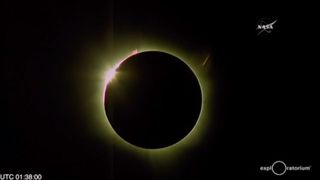

One of the easiest ways to safely watch the eclipse is to use a handheld solar viewer or glasses that are specially made for that purpose. Whether you’re making a trip of it or staying at home, here are some tips to make sure you enjoy the eclipse without damaging your eyes. Staring directly at the sun for any amount of time will damage one’s eyes, so using protective equipment is crucial. A 70-mile wide path from Oregon to South Carolina will see a total eclipse of the sun.īefore making plans to watch the eclipse, it’s important to plan for safety. Most of the country will see at least 75 percent of the sun obscured. 21, 2017, the best total solar eclipse in 40 years will make its way across the United States, providing skywatchers a rare chance to see the moon pass directly in front of the sun.
How to see the eclipse through paper full#
If you really want to take advantage and enjoy the full experience, however, here’s a guideline to make sure you are ordering a pair of certified solar filter glasses that will let you safely see the eclipse directly.DENVER – The most anticipated astronomical event in decades is now just a few weeks away. It’s the same basic process with the eclipse - except the lit objects are the Sun and the Moon, the “lens” is a piece of paper with a hole in it, and the screen is whatever surface you project it onto.Īt the end of the day, a pinhole projector is a fun, quick project for you (or your kids) to view the eclipse. The pinhole only lets a small amount of those reflections through, allowing an image to form (inverted) on the other side of the hole.

So when an object is illuminated, light will continue to bounce off it in a straight line. Generally, light travels in straight lines. Pinhole projectors take advantage of a bit of optical physics known as the camera obscura effect. Now that you’ve got your eclipse-viewing plans sorted out, here’s how this device works. Bonus round: the physics of pinhole projectors D o not look at the Sun directly through the pinhole. Then, using your second piece of paper (or a wall) as a screen, you’ll be able to see an image of the partially obscured Sun, all without burning out your retinas.Īs a safety note: you want to look at the projection created by the pinhole on the wall, so keep your back to the Sun, and look at the image created by the light shining through.

Now that you’ve got your piece of paper with a pinhole, hold it up and let the sunlight shine through it. If you’re really in a pinch, you can even make a pinhole projector by just curling your fingers to only let a pinprick of light through.

If you’re in a rush or on a budget, just take two stiff pieces of paper (paper plates or card stock tend to work well, but even regular printer paper should do the job) and poke a pinhole in one with a pin. There are many ways to make a pinhole projector, but you really just need two things: something with a pinhole in it, and something to project the image on. Putting together a pinhole projector is about as easy as it gets, and while it doesn’t quite have the same “wow factor” as looking directly at the partially blocked Sun, it’ll still let you safely view what’s happening without potentially going blind. 13 things to know about the solar eclipseįortunately, there’s another option: a pinhole projector.


 0 kommentar(er)
0 kommentar(er)
